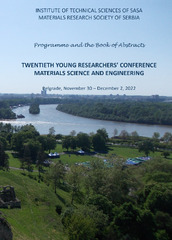Приказ основних података о документу
Bioactives preservation of everlasting (Helichrysum plicatum L.) flowers extract by freeze drying method and powder characterisation
| dc.creator | Mutavski, Zorana | |
| dc.creator | Ćujić-Nikolić, Nada | |
| dc.creator | Radan, Milica | |
| dc.creator | Bigović, Dubravka | |
| dc.creator | Marković, Smilja | |
| dc.creator | Šavikin, Katarina | |
| dc.date.accessioned | 2022-12-19T14:40:55Z | |
| dc.date.available | 2022-12-19T14:40:55Z | |
| dc.date.issued | 2022 | |
| dc.identifier.isbn | 978-86-80321-37-0 | |
| dc.identifier.uri | https://dais.sanu.ac.rs/123456789/13503 | |
| dc.description.abstract | Everlasting flowers (Helichrysum plicatum L.), traditionally used for gastrointestinal disorders such as abdominal pain, jaundice, and hepatic disorders are a rich source of sensitive polyphenolic compounds whose preservation is of great importance. A critical point in the development of formulations with bioactive phenolic compounds, especially liquid extracts is their limited stability at elevated temperatures, pH variations, exposure to oxygen, light, and moisture. In order to overcome the extract limitations, drying method could be the optimal technique for preservation of bioactive compounds, in order to obtain stable powders with appropriate characteristics. One of the most advanced techniques based on the phenomenon of sublimation is a freeze drying, which enabling the long-term preservation of heat-sensitive compounds. In this study, extract obtained by percolation method was lyophilized by freeze drying method (firstly extract was frozen at -80 oC for 1 h, then freeze- dried at -60 oC with pressure of 0.011 mbar for 24 h, and finally main dried at -60 oC with pressure of 0.0012 mbar, for an additional hour in order to remove the capillary water residues). The obtained freeze-dried extract (FHE) was characterized by drying efficiency, the contents of total polyphenols-TPC and flavonoids-TFC. The most dominant polyphenolic compounds were determined and quantified by HPLC method. Differential scanning calorimetry (DSC) and scanning electron microscopy (SEM) analyzes were also performed. The stability of individual compounds, quantified by the HPLC method, was investigated after 30 days, whereby the sample was exposed to a temperature of 40 °C. Drying efficiency was 94.68%, while TPC and TFC were 113.22 mg gallic acid/g and 28.16 mg catechin/g od FHE, respectively. The most dominant individual compounds were naringenin (22.47 mg/g) and kaempferol (21.47 mg/g) of FHE. The DSC method confirmed the FHE stability, and the SEM analysis confirmed that the extract was successfully encapsulated, without visible deformations. The obtained powder showed excellent stability in terms of the content of the dominant individual compounds, with increasing of their content after 30 days. | sr |
| dc.language.iso | en | sr |
| dc.publisher | Belgrade : Institute of Technical Sciences of SASA | sr |
| dc.relation | info:eu-repo/grantAgreement/MESTD/inst-2020/200003/RS// | sr |
| dc.relation | info:eu-repo/grantAgreement/MESTD/inst-2020/200175/RS// | sr |
| dc.rights | openAccess | sr |
| dc.rights.uri | https://creativecommons.org/licenses/by/4.0/ | |
| dc.source | Programme and the Book of Abstracts / Twentieth Young Researchers' Conference Materials Science and Engineering, November 30 - December 2, 2022, Belgrade, Serbia | sr |
| dc.subject | Helichrysum plicatum L. | sr |
| dc.subject | freeze drying | sr |
| dc.subject | percolation | sr |
| dc.subject | polyphenols-TPC | sr |
| dc.subject | flavonoids-TFC | sr |
| dc.subject | differential scanning calorimetry | sr |
| dc.subject | scanning electron microscopy | sr |
| dc.title | Bioactives preservation of everlasting (Helichrysum plicatum L.) flowers extract by freeze drying method and powder characterisation | sr |
| dc.type | conferenceObject | sr |
| dc.rights.license | BY | sr |
| dc.citation.spage | 13 | |
| dc.citation.epage | 13 | |
| dc.type.version | publishedVersion | sr |
| dc.identifier.fulltext | http://dais.sanu.ac.rs/bitstream/id/53912/Mutavski_YRC_2022.pdf | |
| dc.identifier.rcub | https://hdl.handle.net/21.15107/rcub_dais_13503 |

